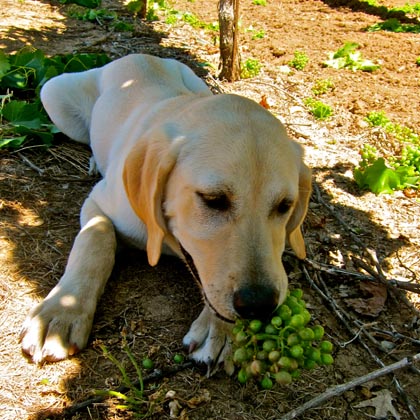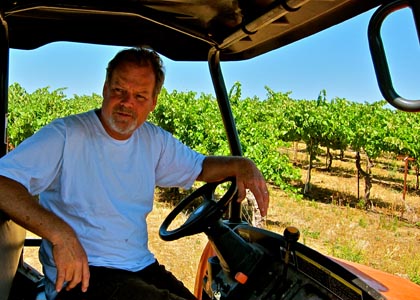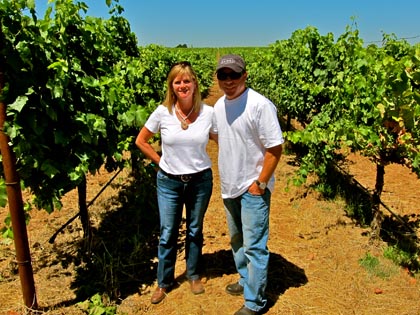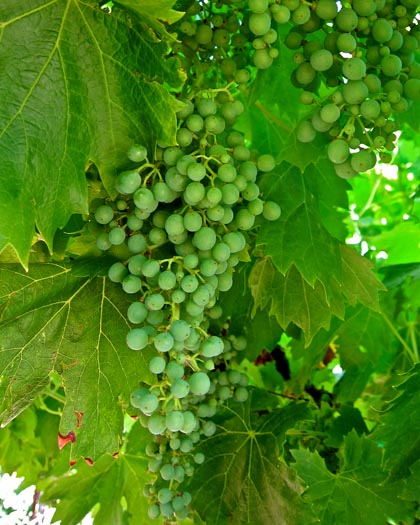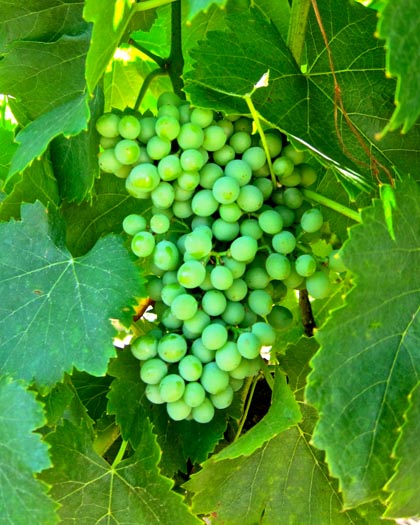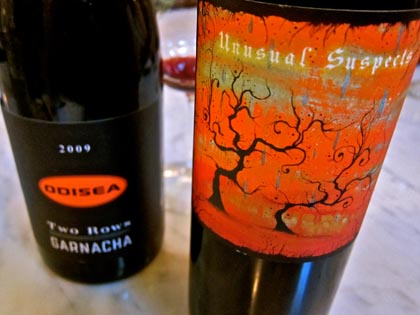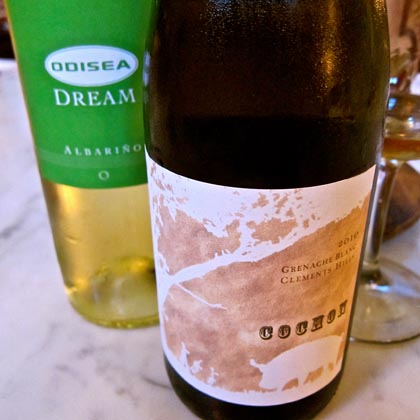Letters from Lodi
An insightful and objective look at viticulture and winemaking from the Lodi
Appellation and the growers and vintners behind these crafts. Told from the
perspective of multi-award winning wine journalist, Randy Caparoso.
Odisea’s delicious roots in Lodi
Odisea pup snacking on green Garnacha
A case for a natural approach to Lodi winemaking…
Odisea Wine Company was one producer that really stood out at the TAPAS (Tempranillo Advocates Producers & Amigos Society) Grand Tasting at San Francisco’s Fort Mason this past June (for an accounting from the Lodi perspective, see this report in Culinary Wine & Food Adventures).
There was something about the Odisea wines – an immediacy, and almost unabashed nakedness – that distinguished it among other Spanish grape specialists in the room that day. There are now, for instance, a growing number of fine, zesty California whites made from the Albariño grape, but Odisea’s version seemed dreamier, lighter, even wispy in its glow and transparency of fruit expression. There was also something wayward about Odisea’s reds; like their starry bright yet strikingly swarthy, meaty, masculine Two Rows Garnacha — like the Albariño, grown in the mild climes and deep soils of the Lodi AVA.
Odisea’s Adam Webb in Lewis Vineyard
Intrigued, we recently dug up the story: this vinous odisea – the Spanish word for “odyssey” – represents the steady, sure footed process of discovery taken on by two longtime friends, who started out purely as wine lovers with a bias towards European wines – especially those of Spain and Southern France – which took them into the industry as merchants and marketers of wine, and then, in 2004, as somewhat itinerant artisanal winemakers (working their craft first in a winery in Santa Cruz, then in Calaveras, and today in a custom crush facility in Napa Valley).
From the beginning, Odisea winemaker/proprietors Adam Webb and Mike Kuenz made Spanish and Southern French inspired wines their fetish; indulged in it with a two-part agenda. The first part has entailed a decidedly European approach to winemaking. For Webb and Kuenz, this means more like winegrowing: the idea that quality is begins and ends with the best possible grapes, and that their jobs as winemakers is to not mess it up with any unnecessary techniques or manipulations. This idealistic quest led them Lodi, where they began sourcing grapes from vineyards farmed by Gregg Lewis (of Dancing Fox Winery & Bakery) and Markus Bokisch (Bokisch Vineyards).
Dancing Fox’s Gregg Lewis in his Lewis Vineyard
Part two is what they’ve been doing with those grapes: handling them with an older, more “natural” European mentality that employs
- Wild yeast fermentation (allowing the natural flora on grape skins to do the work, whereas the vast majority of commercial wines are fermented with selections of cultured yeast because most vintners believe this provides more control over the winemaking process)
-
Gentle handling and racking, allowing them to forgo filtration or fining (the idea being: filtering and fining may clarify wine, but also tends to strip wine of some of its flavor and the unique vineyard derived characteristics)
- Minimal use of new oak barrels in their red wine aging (in order to let grapes and character of the vineyards, rather than wood, predominate in the aroma, flavor and textures)
Here’s the thing: Lodi grows good grapes, but the vast majority of its wines are fermented with cultured yeasts, and filtered or fined out of fear of bottles retaining visible particles that might put off consumers. In regards to oak regimes, most Lodi reds are aged in barrels of mixed ages; although, as in most California wine regions, there is a tendency to use 100% new oak for the “finest” wines since many consumers associate the aggressive, pungent taste of first-year barrels with highest quality wines.
Odisea is definitely contrarian, especially when it comes to vinification. Greg La Follette, a highly respected North Coast Pinot Noir and Chardonnay specialist, has called wild yeast fermentation “not practicing safe winemaking… it’s a style of winemaking that runs contrary to most beliefs, and requires a lot of faith.” Larry Turley, who produces the coveted (and wild yeast fermented) Turley Zinfandels in Napa Valley and Paso Robles, has told us, “we have never hired trained winemakers… we prefer them untrained because, that way, we never have to unlearn them the things they teach in schools like U.C. Davis.”
Webb with Liz Bokisch in Terra Alta Vineyard
Call it sacrilege. Call it foolhardy, or even disrespectful. But there has always been strong empirical evidence that usage of lower strength wild, natural, indigenous yeasts – which can struggle to start and finish fermentations – tend to produce wines of unique qualities that cannot be achieved through cultured (or “inoculated”) yeast fermentations. We’re talking about specific aromatic qualities – like rose petals, mineral, even feral or sauvage notes so typical of naturalistic European and American wines – as well as textural qualities amounting to heightened feel of viscosity.
Looser Caldwell clone of Grenache in Lewis Vineyard
More conventional vintners would say this just isn’t so. Some would just say bunk or batty. Yet, from a sensory perspective, you have to say there are small differences that do make, well, a difference. In a way, the prestige and undeniable critical success of well known California proponents of wild yeast fermentation pretty much speaks for itself: La Follette and Turley, as well as Ridge, Ramey, Neyers, Failla, Frog’s Leap, Chalk Hill, Cristom, Calera, Colgin, Araujo, Marcassin, Paul Hobbs, Rhys, Ravenswood, Siduri, Sine Qua Non, Evening Land… all vignerons who consistently demonstrate that 100% wild yeast fermentation is not only “safe,” it reaps stellar results. Nothing wrong with that.
Needless to say, every one of these producers also knows that actual quality comes from grapes, not winemaking; the minimalist approach, just a means to an end. While walking with Gregg Lewis through the Lewis Vineyard, out in Lodi’s Clements Hills AVA where the terrain starts to roll along the banks of the Mokelumne River, Mr. Webb talked about why this spot has meant so much for Odisea:
“Of the three main vineyards we use in Lodi, Gregg’s gives us the most complex, structured, mineral driven wines, which suits our style; especially for a grape like Tempranillo, which needs that to be interesting. The soil in the Clements Hills comes from deep river deposits. It looks like Ribera del Duero in Spain, although they might have hotter days, and the nights are cool in both places.
“We also can’t help but notice, in the winery, the subtle, secondary mineral qualities in the background aromas of wines from Lewis Vineyard. When I come out and stand here, I can see where it comes from: the deep rootstocks of these vines, plugged directly into this dry riverbed. Gregg grafted his Tempranillo and Garnacha (also called Grenache) on vines originally planted thirty years ago. This is why we have a native yeast philosophy – if we ferment with yeasts naturally populating this vineyard, we’re more likely to get the subtle qualities unique to this vineyard. We know it’s coming from the site, because we also get Tempranillo and Garnacha from Markus Bokisch’s vineyards down the road, and his are different.”
Tighter, smaller clustered Tablas clone of Grenache
Adding to Webb’s visceral insights, Lewis tells us, “I bought this previously planted property in 1985. It was Markus (Bokisch) who inspired me to graft over to Spanish varieties in 2001. Adam started with us in 2004 with these two original rows (hence, Odisea’s Two Rows Garnacha), planted to two separate clones of Grenache – the Tablas clone (from the Tablas Creek Nursery in Paso Robles, source of grapes originating from Château de Beaucastel in the Rhône Valley), and the Caldwell clone (from Napa Valley nurseryman John Caldwell, purportedly a “suitcase” clone from a famous vineyard in Châteauneuf du Pape).”
Says Webb, “in the beginning we were especially taken by the Caldwell clone. When you look at it, it’s a longer, looser cluster than the Tablas, which has smaller, tight clusters. The berries in the Caldwell seem to be thicker skinned, at least in the proportion, and the Grenache we get is darker, with fuller tannin, almost Syrah-like intensity. Whereas Grenache from the Tablas clone is brighter, more feminine, pretty in a floral sense, and more strawberry. Over the years we’ve learned that the wines are better when blended – especially since the Caldwell Grenache can be so big, and our wines are more about finesse – and now we co-ferment the two clones.”
From Lewis, we drove over to Bokisch’s Terra Alta Vineyard on Atkins Rd., also falling within the Clements Hills AVA. From this hilly clay loam site, Webb sources Albariño (“flowery like Spain’s,” he says, “with California kiss of fruitiness”), some Graciano, a little Marsanne and Roussanne, and some outstanding Grenache Blanc.
This was followed by a visit with Liz Bokisch to Bokisch’s Halecky Vineyard, where we watched vineyard manager Angel Tellez’s crew leaf pull and thin Garnacha and Tempranillo down to one cluster per shoot. Both of Boksch’s plantings are certified organic by CCOF (California Certified Organic Farmers). Lewis Vineyard is certified sustainable by Lodi Rules.
Following a snack of artisanal pizza at (where else?) Dancing Fox Winery & Bakery in Downtown Lodi, we sat down with Lewis and Webb to review the current Odisea releases:
2010 Odisea, Dream Clements Hills Albariño ($18) – As with Bokisch’s own bottling of Albariño, starting in 2009 Odisea began to have their fruit picked earlier (at 21° to 22° Brix) than in prior vintages. This has given these whites a lighter alcohol feel, plus a tiny bit more mouth-watering acidity to balance out the naturally juicy, flowery fruitiness of the grape, dripping with peach pit and Mandarin orange sensations. Both natural and partial malolactic fermentation in neutral French oak seems to have added a silky, almost ethereal feel. If anything, it’s the latter qualties that set Odisea’s apart from other Albariños: like a pretty girl who needs absolutely no makeup to enthrall. Speaking frankly, Webb tells us, “I thought our early vintages were a bit strong for our profile — while the varietal character jumped out, the flavors seemed slightly artificial. In the 2010, though, I think we may finally be getting what we’re after — a more natural, subtle character.”
2010 Cochon, Clements Hills Grenache Blanc ($25) – Since there is more of a French bent to this wine (blended with small portions of Rousanne and Marsanne), Webb and Kuenz bottle this under the Cochon moniker. You might think, $25 for a Grenache Blanc? But trust us, this one is omg good: outrageously fragrant, billowing nose of white peach, apricot and tropical flowers; turning honeyed, melony, exquisitely quince-like in the flavor, wrapped in silky, swirling, creamy layers within crisp edged, medium-full parameters. Simply the finest bottling of Grenache Blanc we’ve ever tasted (including any from France). Use of 300 liter hogshead barrels, Webb tells us, gives them the oxidative benefits of wood aging (particularly, enhanced textural qualities) without adding the flavor of oak. Everything, it seems, working like a charm for them.
2009 Odisea, Two Rows California Garnacha ($25) – While sourced primarily from Lodi’s Lewis Vineyard, 5% of this red comes from a 90+ year old Mendocino vineyard (hence, the California designation). You would be hard pressed to find a Grenache based red from anywhere in the world (Southern France and South Australia included) as upbeat and brass cojones-ed as this: super-pungent spices (black pepper, cardomom, hints of anise) suffusing red currant-like fruitiness, veering towards honeyed raspberry liqueur; vibrant with natural acidity, pushing the fruit qualities into “opulent” realms on the palate, solidified by a dense yet rounded tannin feel. More amazing: you get the absolute feel of oak aged wine (i.e. the mass and cohesion) with nary a sliver of wood in the taste. Ah, this is what “wine” tastes like.
2009 Odisea, California Unusual Suspects ($21) – Artful blend of Grenache (25%), Tempranillo (25%) and Carignane (50%) from old vines grown on the westerns side of Lodi’s Mokelumne River AVA; the natural fermentation and neutral French oak regime pushing the multiple fruit sensations front and center: sweet, piquant, woodsy red berries (black cherry/cranberry/pomegranate) mixed with whiffs of stones, rare beef and leather; and on the palate, a broad shouldered feel, yet textured like soft leather under a lacy veil of silk. It’s different “suspects,” says Webb, because it showcases the Carignane’s earthen red berry taste by contrasting it with the vibrant, perfumed qualities of Grenache and the meatiness of Tempranillo.
2009 Odisea, Clements Hills The Temp ($21) – In this 100% Tempranillo, Webb and Kuenz zero in on the somewhat wild, thick, meaty qualities of the fruit they get from the young vines in Bokisch’s Halecky Vineyard, with smaller proportions from Lewis Vineyard and Bokisch’s Liberty Oaks in the Jahant AVA. Here, perfumed black cherry is tinged with leafy, olive-like notes and suggestions of red game, while fleshed out by solid tannin and the roasted beef qualities of the grape. The inspiration, says Webb, is definitely Ribera del Duero, famed for its elementally dark, masculine, pungent, often downright hirsute styles of Tempranillo based reds.
Mokelumne River winding past Lewis Vineyard
